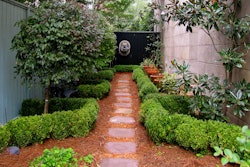
For those who have been in the business for many years, like Joe Raboine, national design and training specialist on the Belgard Design Studio team, there are a few key questions to ask yourself before heading into a pitch, such as: What elements do you focus on when pitching a design to a customer; what are some of the most common mistakes that happen; and what are the best ways to conduct, wrap up and close a pitch?
Taking time to prepare yourself beforehand can pay off in the long run, and it can help you walk into your meeting confident and ready to handle whatever comes your way.
To find out more about different methods Raboine has tested and learned from over the years, check out his advice below.
What to focus on to avoid common mistakes
When it comes to presenting a design pitch, Raboine says that the number one question to ask is how will the homeowner envision using the space.
“Do they intend to host large gatherings, or primarily will it be with just a handful of people enjoying a meal or sitting by the fire?” he asks. “Once you understand their primary goals for the space, then you can start to hone in on key features such as cooking/dining areas, fire features, shade structures, etc., and size them appropriately for the number of people they are hosting.”
When pitching a design, it’s important to keep in mind that the project is about the customer, not your bottom line. Coming into a pitch with the sole purpose of making money and gaining a new customer is the wrong way to view the encounter, and more often than not, an attitude like that will send potential customers running for the door.
Raboine agrees that the number one mistake that typically occurs when it comes to delivering design pitches is that designers/contractors jump right into discussing budgets and products instead of taking time to connect with their clientele.
“Most people have no idea what these spaces cost, and until they see something they like, cannot articulate what they are willing to spend,” he says. “Many times, this is the first question asked, and it immediately puts the client on the defensive because the focus appears to be all about the price; totally wrong approach.”
Raboine adds that the same can be said for product-centric approaches.
“Customers care about the product in that they want it to be durable, beautiful and they want it to blend with their home,” he says. “However, when you start there instead of the overall project, it can quickly confuse things and derail the discussion that should be happening, which is how do you intend to use this space?”
Selling the job and gauging interest
As previously mentioned, establishing good relationships with your clients is the best way to ensure a smoother time working together.
Customers drive and make a business, so be sure to pay close attention to them, their needs and suggestions they may have on helping boost your brand. By staying connected to your customers, you’ll have a better idea of what’s working and what needs some tweaking in your company.
When the clients can trust you to look out for their best interests and not just try to make money, they will be more willing to sit and talk with you, hear your suggestions and work with you in the future.
Raboine agrees that establishing trust with your clients is the number one way to truly sell a job.
“Homeowners are terrified about dealing with contractors,” he says. “Getting work done at your home can very disruptive, both physically and emotionally. So, I would say make sure you spend the time getting to know each other. Be open and honest about what to expect (both ways), and let your client know that no matter what may arise, that you are committing to them that when all is said and done, they will have a well-designed and well-installed project for years to come.”
Once that relationship is established, it’s safe to move on to the designing and contractual stages. Raboine says that without first establishing this relationship, the overall process of executing a project where both parties feel it has gone well becomes very difficult.
“The goal is to create the win-win situation where hopefully you are invited to their first party on their new space,” he says.
The pitch
Once you’ve successfully established a good relationship with your customer, it is then time to begin the pitch.
While it’s important to remember that each customer is different, after the overall idea of the space has been decided on, Raboine says that there is a somewhat scripted approach to finishing out the conversation.
“For instance, if they mentioned they would like a fire feature, you can start showing them fireplaces and fire pit ideas,” he says. “The same goes with cooking and dining. Show them grills, kitchens and brick ovens. Once you have shown them the types of features available and given them an idea of what those features may cost, you can then start to discuss the overall space and how those items will be incorporated into an overall design, and how that design and those features will fit into their yard and budget.”
Every pitch will be unique and, as noted previously, every customer is different, but as the meeting progresses, typically you will be able to read the customer and know whether they are buying into your suggestions or not.
Even though it may be difficult with time constraints and schedules, Raboine encourages meeting your customers in person to present a pitch. While it won’t guarantee that the pitch will be successful, it does greatly increase your chances by enabling you to meet the customer face-to-face, establish a relationship and look them in the eye.
“Doing so will really give you insight into their body language,” he says. “When people smile, lean in and listen intently and ask a lot of questions, you know they are engaged and interested. If they are smiling and nodding and looking at their significant other with a smile, you know they are close to closing. Again, it’s impossible to ‘read’ these signs if you are not there in person. So, don’t email or mail them back the design; present in person!”
Sealing the deal is sometimes easier said than done, but Raboine suggests taking the simple route of just discussing how the design process will go and what the possible cost of the design will be.
“The goal at this stage is to really get the client comfortable with you, your company and to set the stage for the presentation of the plan on the next meeting,” he says. “Most people are put off by a hard sell and on the first meeting are really trying to fact find and hopefully establish a rapport with a contractor.”
Virtual reality
One new age element that Belgard has taken advantage of in recent years is incorporating virtual reality into their design pitches.
The VR element of design allows contractors to send in their ideas and plans, and the designs will then be plugged into the VR system. This, in turn, creates a three-dimensional experience that brings the customers into the space and allows them to see firsthand where everything really will sit in their landscape.
“There is a night and day difference between presenting a 2D or 3D hand-drawn plan versus a 3D render, animation or VR experience,” he says. “While some people can discern the end result from looking at an overhead or sketch, the vast majority cannot connect all the dots, especially if there are a lot of vertical details such as walls, pillars, fireplace, etc.”
Raboine says that with all of the different color and texture options available in the design market, it’s now more important than ever to be able to have this VR option on hand.
“Even an experienced industry veteran can have a difficult time putting all them together in their head,” he says. “With 3D models, however, all that’s changed. Now, both the designer and client can see exactly what the project will look like in the existing environment. The power this has is amazing.”
Raboine reports that since introducing the Belgard VR element, the company has seen the time it takes for a contractor to close a sale go from approximately 20 hours to only four or five on average.
Raboine adds that since introducing the VR element, contractors are now seeing 85 percent plus closure rates, higher margins and customers that are much happier. According to Raboine, the results are now speaking for themselves and are transforming the sales process.
“All the ‘gray’ is gone and there’s no confusion about what is going where or how it’s going to end up,” he says. “Contractors are now closing projects on the second meeting, in a quarter of the time it would have taken them before with a 2D sketch. VR takes it one step further by fully immersing the client in their new space. The emotional connection that happens results in the most frequently asked follow-up question: When can you start?”










